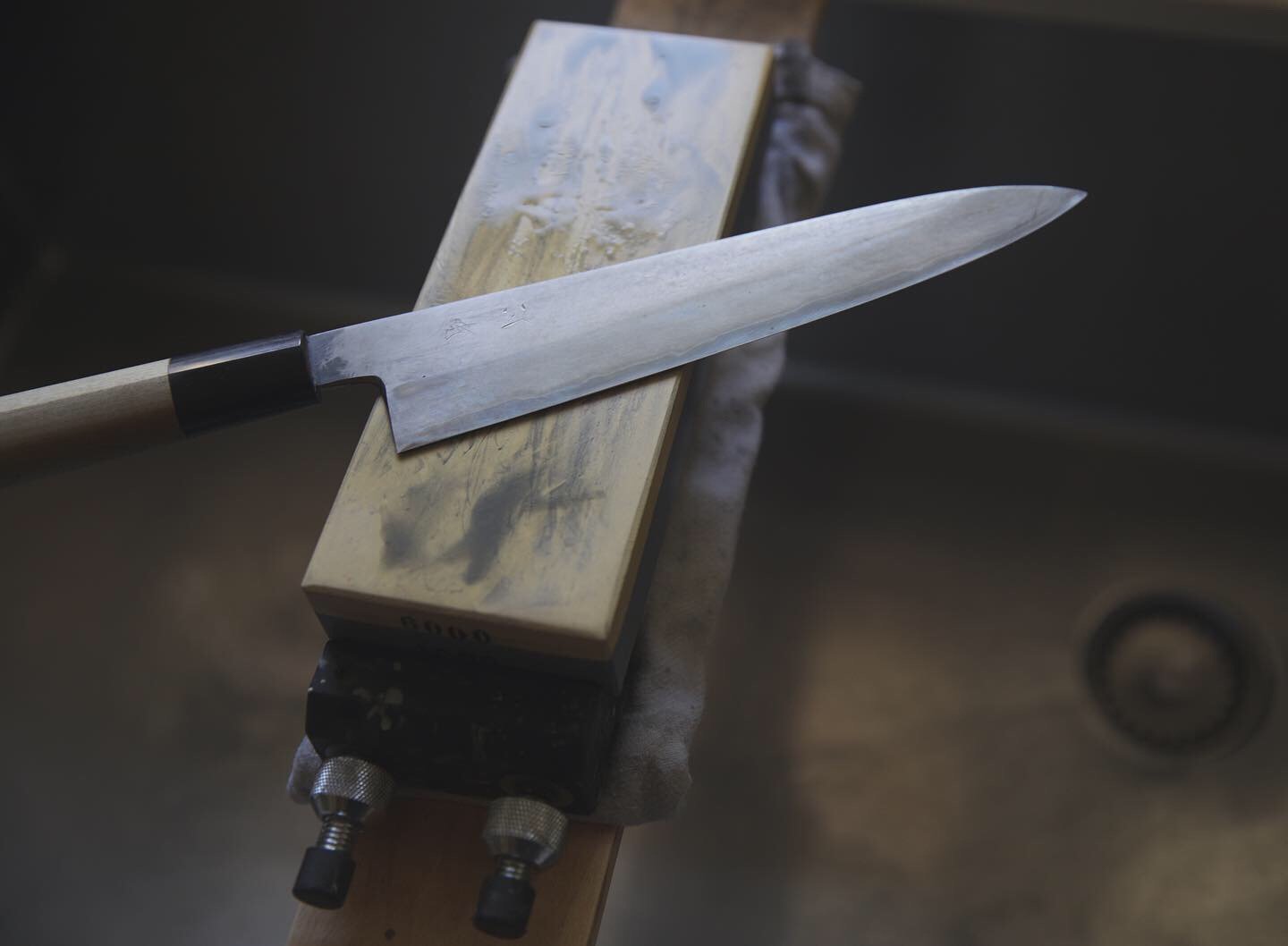
KNIFE CARE
Proper maintenance will ensure that you get a lifetime of use from your kitchen knives. Follow the care instructions below to keep your knives sharp and in good condition.
The short version
I make both stainless and high carbon chef knives, but I’m going to be focusing on carbon steel in this knife care guide as most people are already familiar with stainless steel. And while I’ll be mainly talking about carbon steel knives, keep in mind that the tips below would benefit all your culinary knives.
Taking care of a carbon steel kitchen knife is not as daunting as you may think. It basically boils down to this:
The only extra care that carbon steel needs over stainless steel knives is that it needs to be hand-washed and fully dried immediately after use.
I'd also be doing a disservice by not teaching you this important mantra— please repeat after me... "The dishwasher is the enemy of all knives."
Okay, now onto the long version...
How to care for carbon steel knives
Although stainless steel is the most common material for commercially available kitchen knives, carbon steel knives are often the preferred choice of culinary professionals and kitchen knife enthusiasts. That's because a carbon steel blade is generally* easier to sharpen and can hold a sharp edge longer than most stainless steel knives.
The cost of this performance improvement is that carbon steel involves a bit more maintenance.
* Improvements in modern stainless alloys have pretty much closed the gap between some stainless alloys and carbon steels. The AEB-L stainless steel used in Medeiros Knives is, pardon the pun, cutting edge. It's easier to sharpen and will hold an edge longer than other stainless steels and performs about as well as carbon steel.
Over time, your carbon knife will develop a grayish-blue patina. Don't panic! There's a difference between patina and rust. Patina = good; rust = bad. A healthy patina actually protects your knife from rust. A large number of carbon steel knife owners actually force a patina early on using various acidic foods or liquids such as mustard or vinegar.
As you use your knife more and more, you'll see this patina developing and darkening over time. It's your knife's personal history.
If you’re not a fan of this look, don’t fret, you can still use carbon steel knives and keep that shiny look by polishing them and oiling them regularly.
If you do start to develop a little rust, you can try scrubbing it with the rough side of a sponge, or better yet, a rust eraser.
Patina vs Rust
Regular honing or stropping helps keep your blade edge centered, which makes cutting easier. If you bought a set of knives, your set may have come with a honing rod. If you need to buy one, I suggest a smooth ceramic one at least 10-12" long.
I generally hone or strop my knife two or three times a week if I’m using it daily. Sharpening, which involves removing material from a knife to create a fresh edge, should be done considerably less frequently— an average home cooks can get away with once or twice a year, while someone who uses their knife all the time might want to sharpen quarterly or even monthly depending on their tolerance for sharpness.
When it's time to sharpen, avoid those pull-through or electric sharpeners. They take off too material and will shorten the life of your blade by years. If possible, use a Japanese water stone or take it to a professional sharpening service. If it's a Medeiros knife, send it back and we'll sharpen it for free, but you’ll have to cover shipping to and from the workshop.
Keep your knives sharp
It's a good idea to work on the proper cutting surface. A wood cutting board, preferrably end-grain, is probably the best option for most people. You can also check out high quality synthetic options such as Hi-Soft or Sani-tuff.
Avoid hard surfaces like glass or marble. They will quickly dull or chip your edge.
Bamboo cuttings boards are… okay. They’re a little harder and contain silicates so they’ll dull your knife a bit faster than end-grain wood or synthetic cutting boards. If you’re shopping for a nice, new cutting board I’d avoid them. But if it’s what you got or can afford, don’t sweat it, just keep you edge honed and sharpen when you need to.
A quick note about cutting boards
One of the most important steps in taking care of your carbon steel is keeping the blade clean and dry. That means wiping down your knife every once and while as you cook. It sounds more tedious than it actually is and it will keep your blade from rusting until a healthy patina develops.
I wipe the blade on a folded kitchen towel after each chopping task. If a recipe calls for a clove of garlic minced, an onion chopped, and a tomato diced. I'll mince the garlic, wipe the knife. Chop the onion, wipe the knife. Dice the tomato, wipe the knife. This is important with acidic foods. And especially important early on before your carbon blade develops its protective patina.
Clean as you cook
After you're done using your knife, wash it immediately in warm, soapy water. Don't let the knife sit in a sink full of dishes, where it can get dinged up and rusty. One last time— under no circumstances should you ever put it in the dishwasher.
Once you've hand-washed your knife, dry it immediately and then put it away. A knife block, a sheath, or a magnetic knife strip are all safe options for your knife. Just don't throw it in a drawer unprotected where it could get scratched, dulled, or chipped up.
If you don’t plan on using it for a long while (a few weeks+) or live in a very humid environment, you may want to give it a light oiling with one or two drops of tsubaki oil per side before putting it away. A bottle of tsubaki oil is included with every carbon knife purchase.
After each use
All that said, no matter how well you take care of you knife, it may need a tune-up down the line and I have you covered:
I’ll sharpen and refurbish your knife free of charge if you cover the shipping costs to and from the workshop.
Medeiros Knives are guaranteed against failure in workmanship assuming reasonable use and care of the knife. In the event of a materials or workmanship defect, I'll determine the appropriate method of repair, replacement, or refund.
This guarantee doesn’t cover abuse or mishandling. Please don’t try to chop open coconuts with a fine-edged gyuto…



